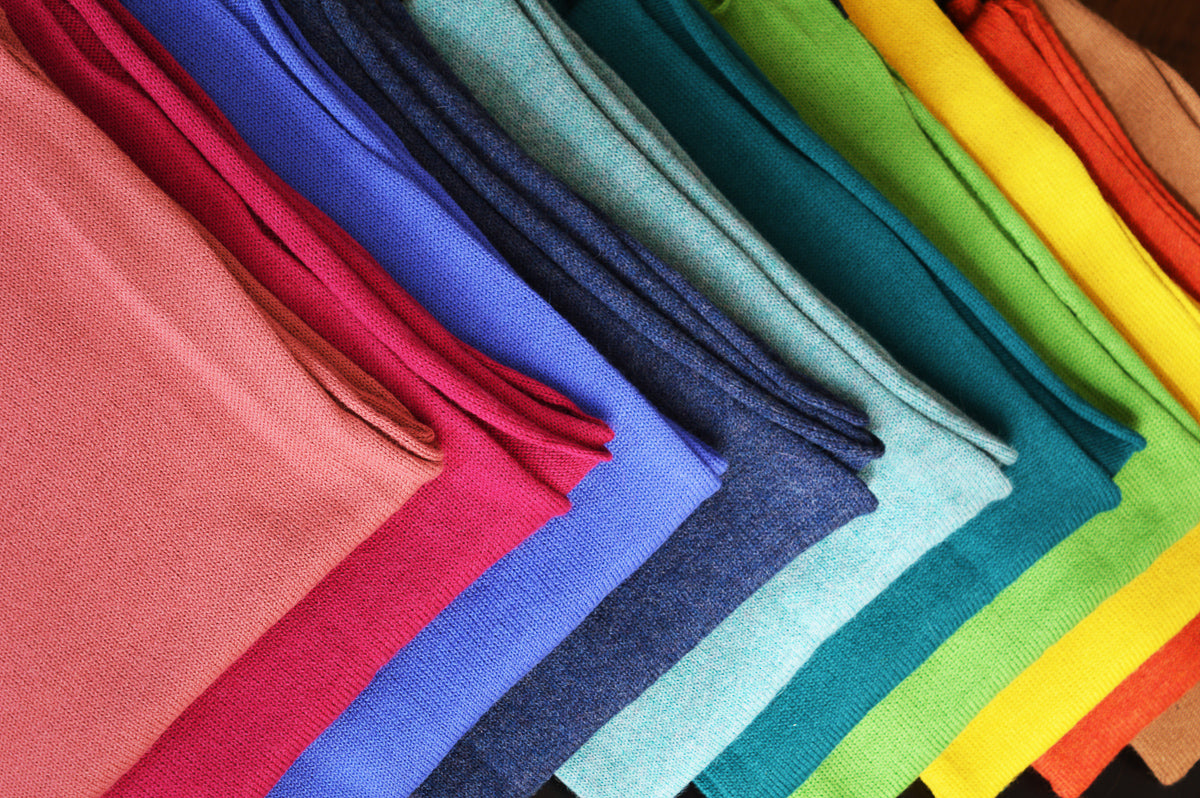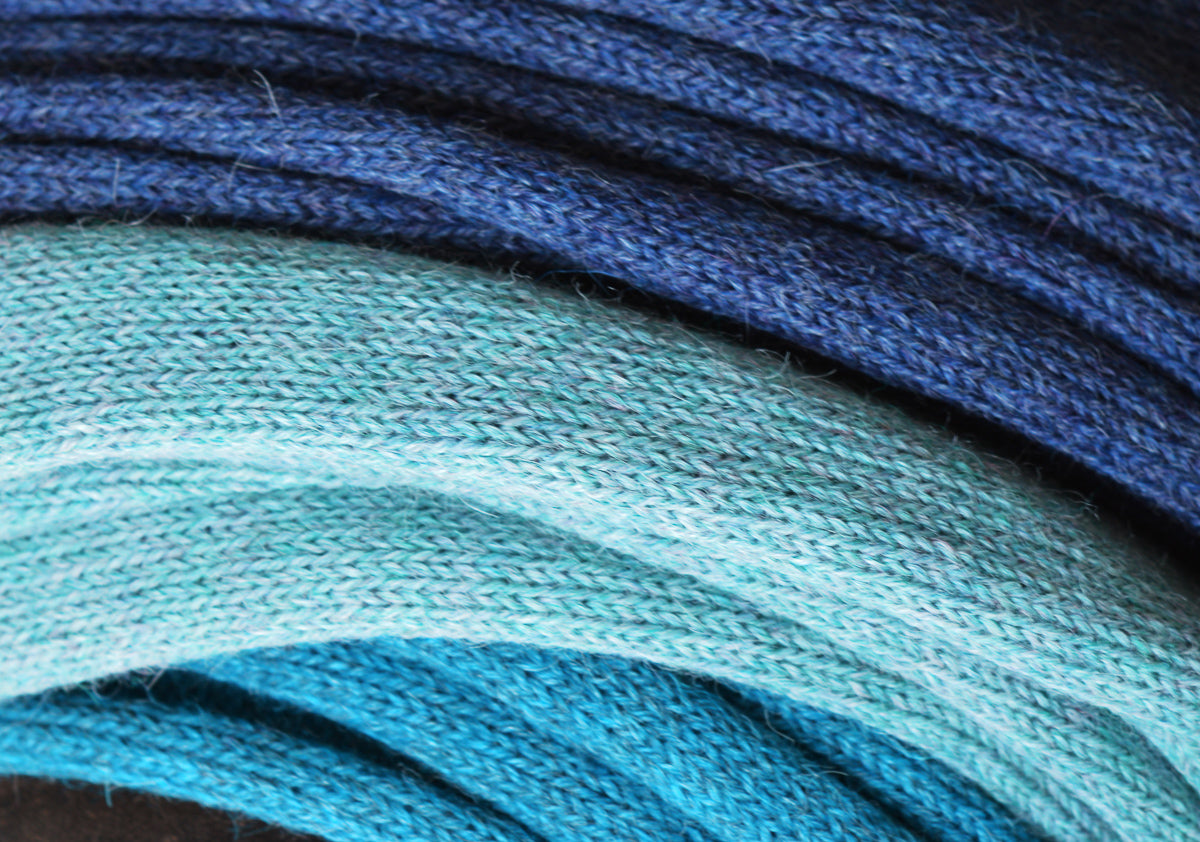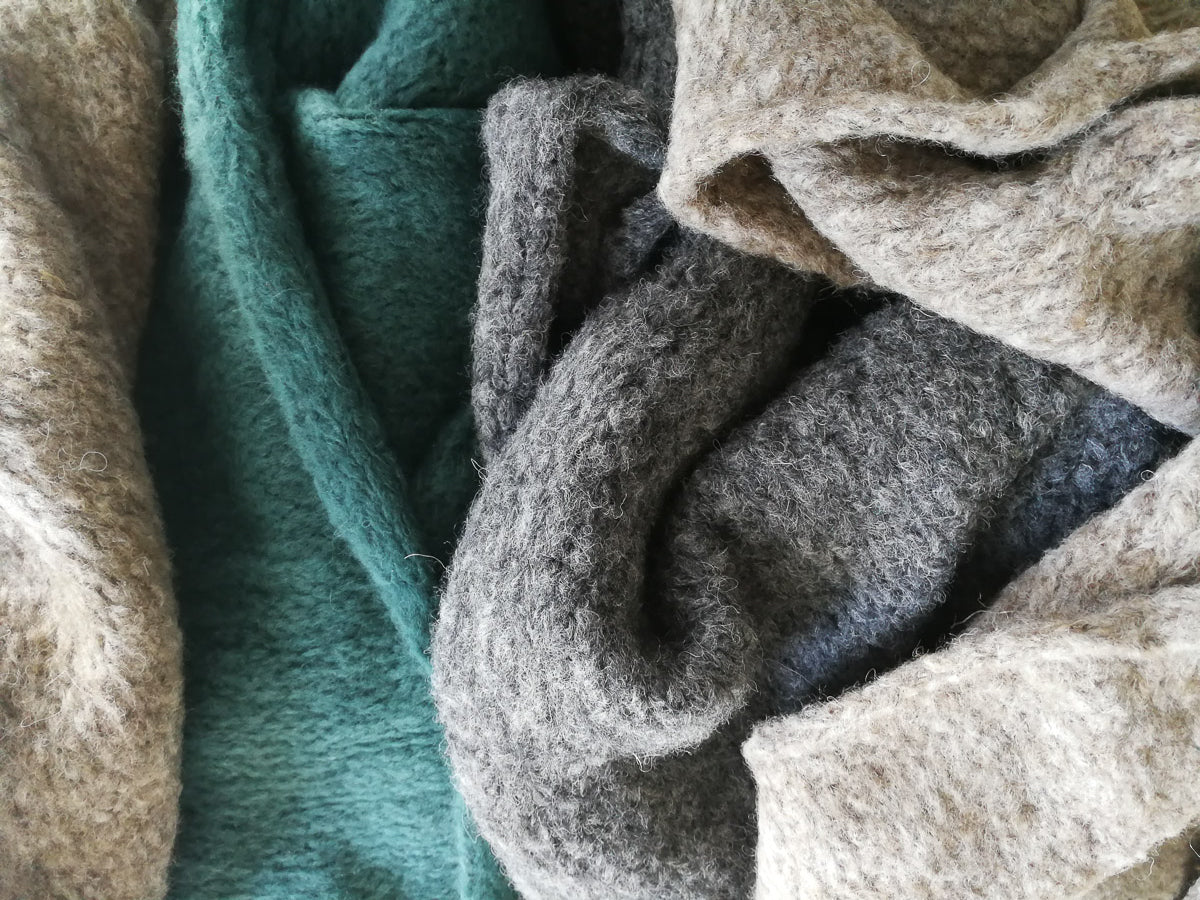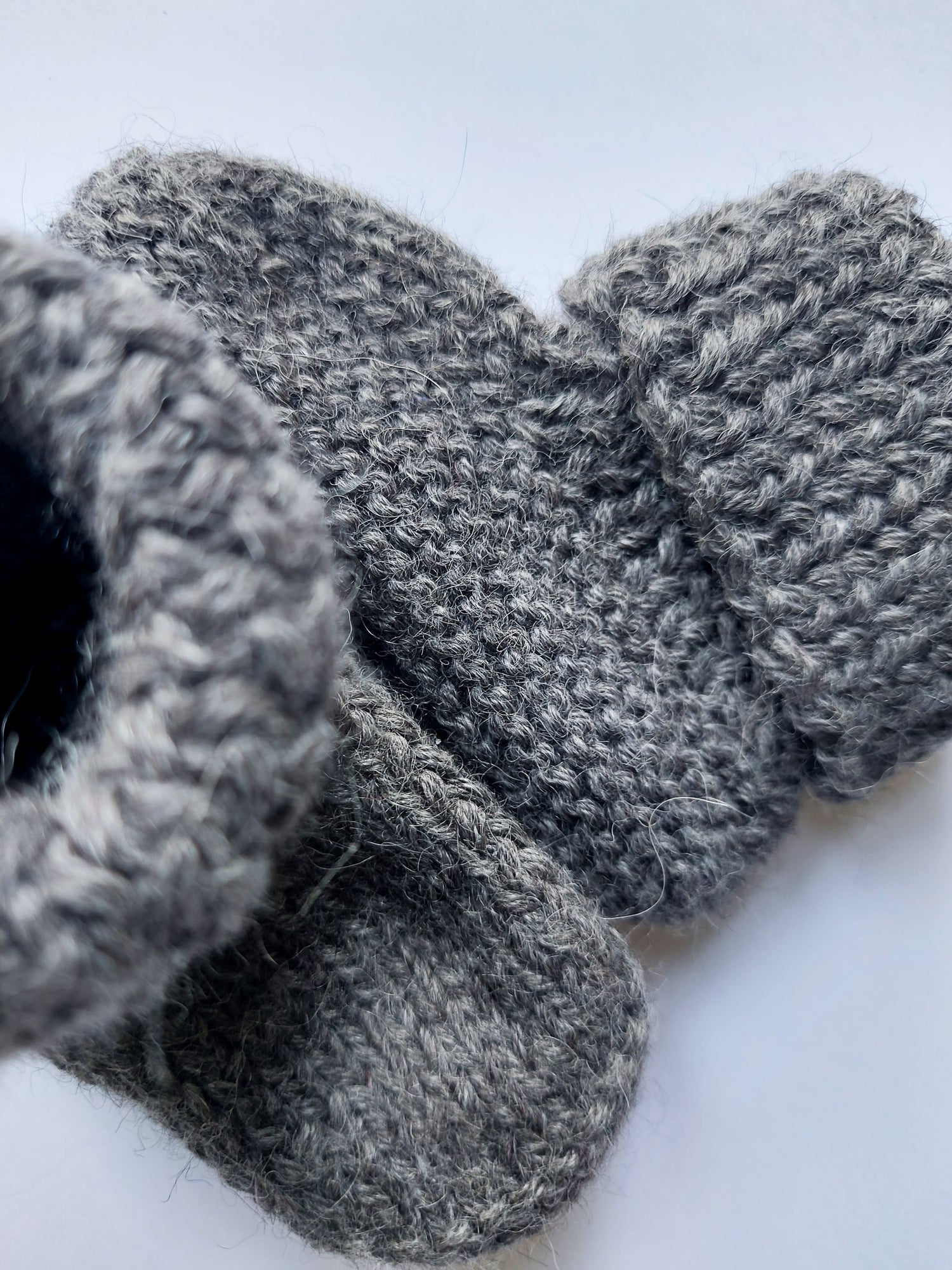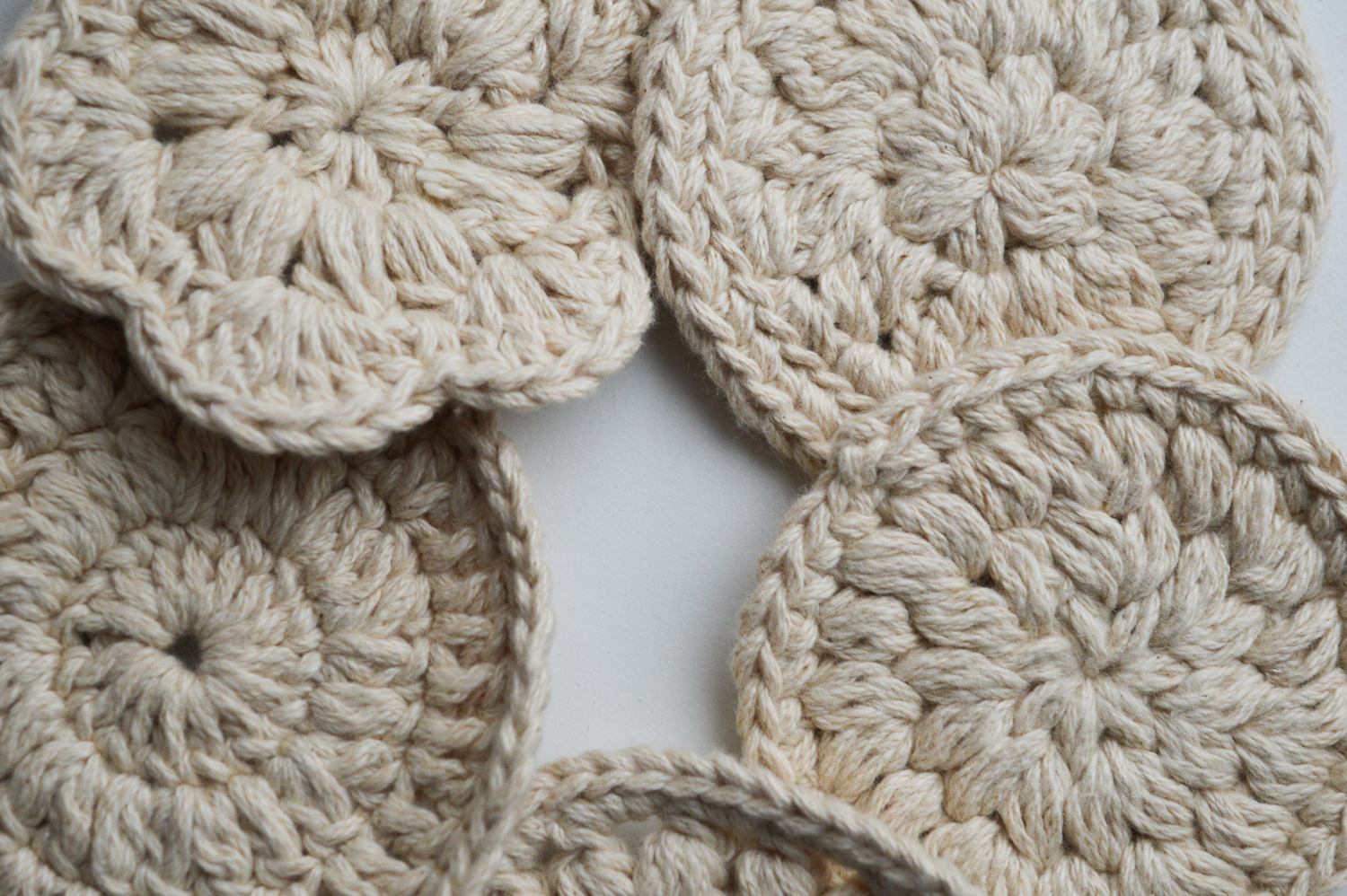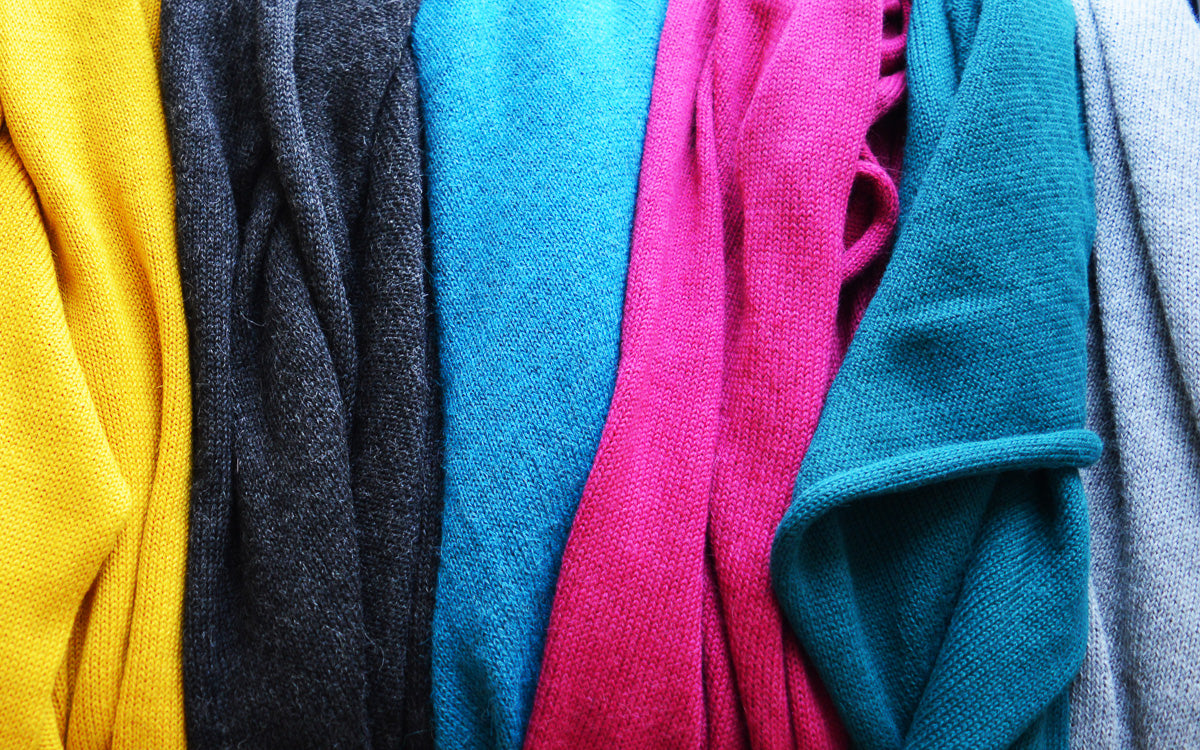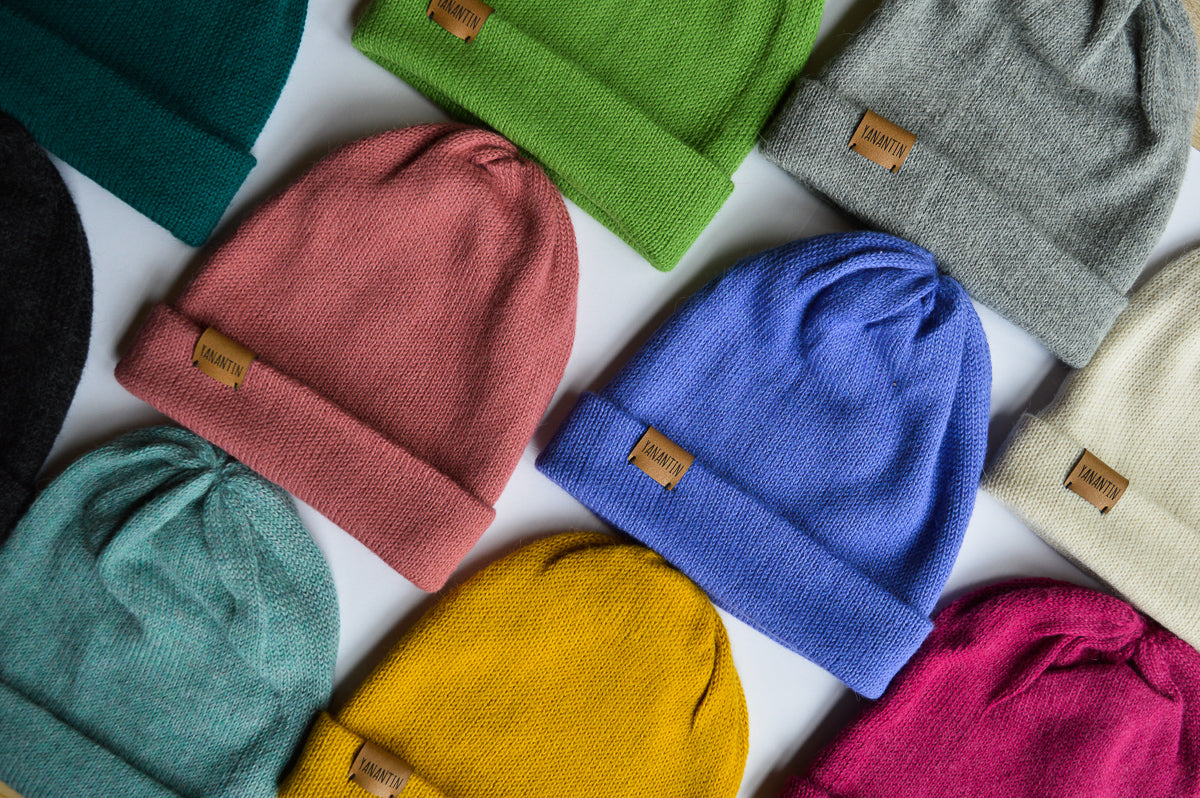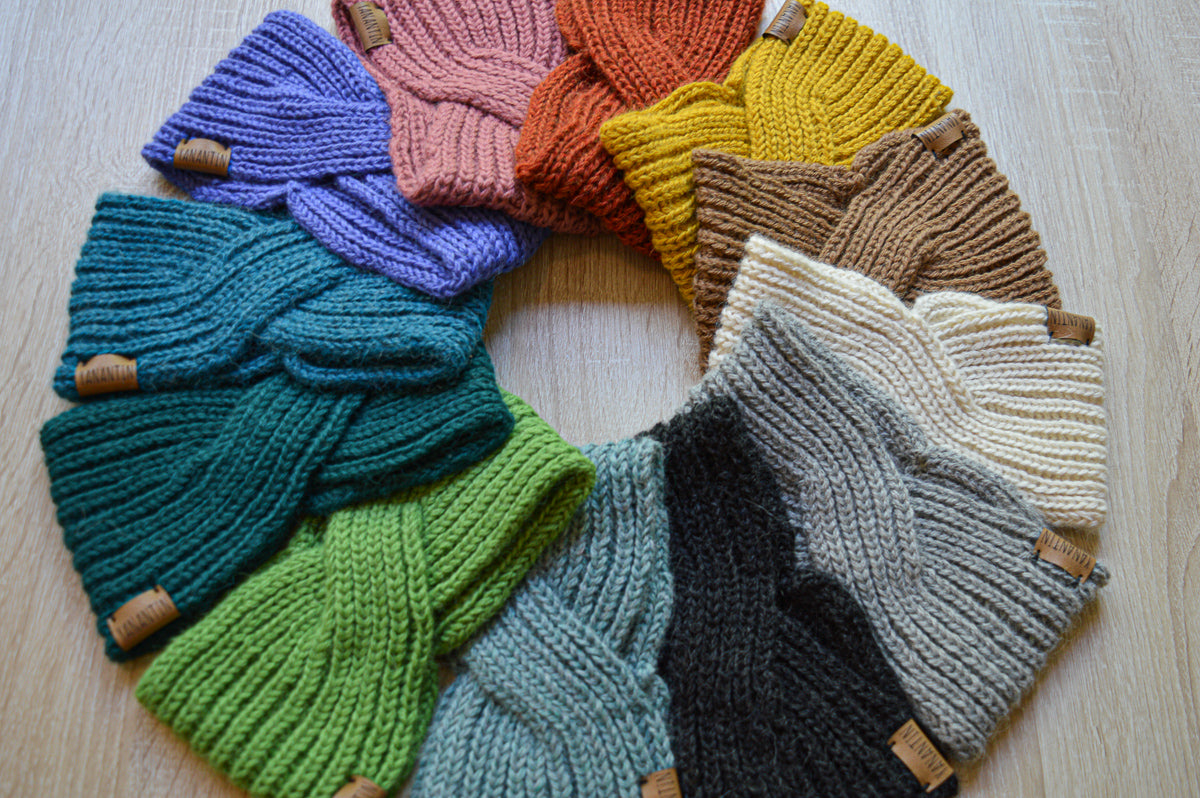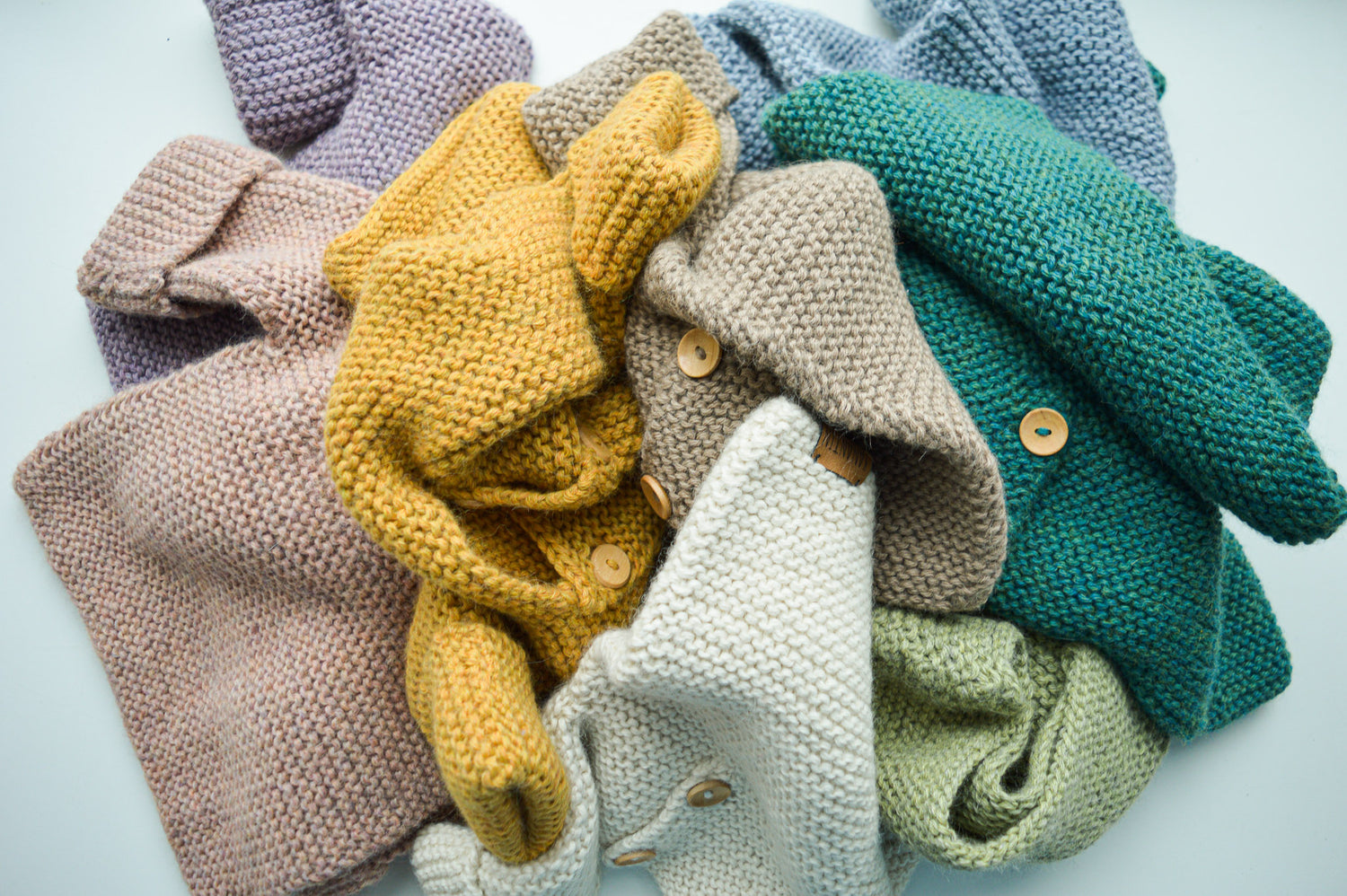It’s no secret that I absolutely LOVE alpaca wool. But let’s be honest, it’s not perfect either. And sometimes, a wool blend can give you just that little extra of whatever it is you're looking for.
These are my favorite alpaca wool blends
-
Best for affordability: Alpaca + Acrylic or Alpaca + Regular Wool
-
Best for sensitive skin: Baby Alpaca + Organic Cotton
-
Best for breathability in warmer weather: Alpaca + Bamboo, Baby Alpaca + Linen, Baby Alpaca + Rayon
-
Best for durability: Alpaca + Nylon or Alpaca + Recycled Polyester
-
Most eco-friendly: Alpaca + Hemp, Baby Alpaca + Organic Cotton, Suri Alpaca + Tencel, or Baby Alpaca + Linen
-
Best for all-around fashion: Baby Alpaca + Silk
-
Best for high-end luxury fashion: Royal Alpaca + Cashmere
1. Baby Alpaca + Silk
Those who are looking for softness and elegance will find heaven in baby alpaca and silk blends. It’s luxurious with a function thanks to the silky drape and alpaca warmth.
How Silk Makes Alpaca Better
Silk adds lustre, lightness, and drape. Pure alpaca can feel dense and matte; silk corrects this and creates a more luxurious feel suitable for high-end scarves or shawls. Silk adds elegance and reduces bulkiness.
- The Perfect Choice: This combination is perfect for high-end knitwear and exclusive gifts. Keep in mind that it’s not the cheapest blend, but again, perfect if you want quality.
Avoid if you need durability or low-maintenance items.
2. Regular Alpaca + Merino Wool
If you want the warmth of wool but not the price-tag of pure alpaca, wool blends provide a great solution. Regular alpaca with merino makes great sweaters, beanies, mittens, and socks. It’s great for everyday, warm garments.
How Merino Makes Alpaca Better
Merino increases elasticity and resilience, especially in garments that shouldn’t lose their shape (e.g., sweaters or hats). Alpaca lacks natural elasticity, which can lead to sagging. Merino wool improves structure and bounce.
- The Perfect Choice: A blend of alpaca and merino is great for people who want warmth at a lower cost, while avoiding synthetics.
Avoid if you’re looking for a hypoallergenic fiber, merino can still irritate.
Bonus Blend: Baby Alpaca + Merino WoolBaby Alpaca + Merino Wool is a refined version of the standard alpaca/merino blend—softer, more premium, and better suited for garments that need both comfort and structure. This combo is the winner of balance: so if you're looking for a go-to blend that balances comfort, warmth, and everyday wearability, baby alpaca + merino is an excellent candidate—less precious than cashmere, more elegant than regular wool.
|
3. Suri Alpaca + Bamboo Viscose
Suri alpaca is known for its silky, straight fibers, just like bamboo. On top of that, bamboo is naturally cool and breathable. A wool blend of suri alpaca and bamboo viscose is therefore perfect for lightweight garments that you can use in temperate regions.
How Bamboo Makes Alpaca Better
Bamboo viscose introduces moisture-wicking, coolness, and even more silkiness. Good for warm-weather wear or drapey garments. Bamboo viscose makes alpaca usable in slightly warmer climates and adds flow.
- The Perfect Choice: If you’re looking for lightweight tops or shawls that you can wear in fall and spring, this is your go to.
Avoid if you want insulation or structure, this blend is soft and drapey.
4. Royal Alpaca + Cashmere
Royal alpaca is the finest grade of alpaca wool, usually below 19 microns (that’s incredibly soft!). Combine royal alpaca with cashmere and oyou have yourself a true luxury item. Great for scarves, sweaters, or boutique garments.
How Cashmere Makes Alpaca Better
Cashmere enhances softness and luxury, pushing how comfortable it feels to its limit. Cashmere makes an already luxurious fiber even more luxurious!
- The Perfect Choice: Perfect for those once-in-a-lifetime purchases or gifts.
Avoid if you are on a budget or need durability.
5. Regular Alpaca + Nylon
Outdoor enthusiasts, this one is for you! If you want to wear alpaca wool on your next hiking adventure, a blend with nylon will make it more durable. Alpaca wool alone does not really uphold abrasion, so a synthetic blend makes it stronger.
How Nylon Makes Alpaca Better
Nylon provides durability and abrasion resistance, critical for socks or outdoor garments. Alpaca alone is prone to pilling and has low tensile strength. Nylon increases wear resistance and lifespan.
- The Perfect Choice: An alpaca and nylon wool blend is great for outdoor socks, hiking gear, gloves, and technical knitwear. However, nylon decreases alpacas wool’s breathability slightly.
Avoid if you want an all-natural garment.
6. Baby Alpaca + Linen
Nothing worse than a sticky garment when temperatures change. Baby alpaca blended with linen is perfect for in-between seasons. So that when you don’t know what to wear (because warm + cold), you have something that is breathable and warm at the same time.
How Linen Makes Alpaca Better
Linen brings breathability and crispness. This blend works well for spring/autumn pieces that need insulation without overheating. Linen also reduces heat retention and increases versatility across seasons.
- The Perfect Choice: Great for mild climates and for those looking for naturally breathable warmth.
Avoid if you want elasticity, as linen reduces your freedom of movement slightly.
7. Suri Alpaca + Rayon (Tencel or Modal)
The sustainable fashion consumer inside you will be delighted with this wool blend of suri alpaca and different types of rayon. Rayon is a semi-synthetic fiber, and although that’s already a step up from fully synthetic fabrics, there’s two important things to consider:
- Rayon is a general category for fibers made from regenerated cellulose (often natural, like wood pulp). However, the way it’s made, varies per subtype, and can really impact sustainability.
- Tencel uses a closed-loop process with a non-toxic solvent and is the most environmentally friendly type of rayon, since it prioritizes sustainable production processes.
- Modal also uses regenerated cellulose, but doesn’t always include closed-loop production systems and uses stronger chemicals than tencel. So, depending on the producer, modal is not guaranteed environmentally friendly. However, modal is softer than tencel.
How Rayon Makes Alpaca Better
Rayon improves alpaca wool by increasing softness, breathability, and moisture control. It also enhances drape and manageability, helping garments conform naturally to the body while maintaining a high-quality appearance.
-
Tencel (lyocell) adds strength, durability, and sustainability.
-
Modal enhances softness and comfort, making the fabric smoother and more wearable.
The Perfect Choice: Great for ultra-soft, breathable garments like soft dresses and fashion knits. As a semi-synthetic fiber made from renewable cellulose, rayon supports more sustainable and eco-conscious fashion.
Avoid if you need cold-weather insulation, as rayon reduces the suri-warmth.
8. Baby Alpaca + Organic Cotton
Supersoft, natural and hypoallergenic: baby alpaca blended with organic cotton is your go-to for sensitivities. Both fibers are mega soft and breathable, so this blend is perfect people with allergies or sensitive skin.
How Organic Cotton Makes Alpaca Better
Organic cotton adds breathability, softness, and hypoallergenic properties. When paired with alpaca (already low in lanolin), it creates a blend that’s very skin-friendly—ideal for babies or eczema-prone skin.
Cotton makes alpaca better for those sensitive to animal fibers, and more breathable for warmer climates. However, it has less thermal insulation and elasticity than other blends.
- The Perfect Choice: From baby clothes to baselayers, anyone with skin sensitivities or wool allergies, will love wearing this blend.
Avoid if you want stretch, warmth, or long-term durability.
9. Regular Alpaca + Acrylic
Want the wool but not the cost? Look for alpaca wool blended with acrylic. You’ll get most of the benefits (at least partially), without breaking the bank. Perfect if you want to test out alpaca wool before you commit.
How Acrylic Makes Alpaca Better
Acrylic significantly lowers the cost and makes garments easier to care for. Ideal for fast fashion knits like sweaters or accessories. However, synthetic fibers like acrylic reduce breathability. They’re also not sustainable (although still one step up from 100% synthetic!)
- The Perfect Choice: Acrylic makes alpaca wool accessible to budget-conscious shoppers, while still using partially natural fibers. Also great if you want alpaca wool that is machine-washable.
Avoid if you prioritize sustainability and want to commit to quality, since acrylic also decreases durability.
10. Regular Alpaca + Regular Wool
For those who don’t mind a bit of itch, combining alpaca with regular sheep wool is a great option for a more affordable, yet natural fiber. However, regular sheep wool is slightly scratchy, so you want to make sure that you will be able to wear a protective layer underneath.
How Regular Wool Makes Alpaca Better
Regular sheep’s wool (not-merino) adds structure, elasticity, and cost-effectiveness. This blend is often used for blankets or outerwear where softness isn't a priority. Regular wool is also sturdy, so this blend doesn’t give in on durability. However, wool is coarser, so expect some itchiness!
- The Perfect Choice: For outerwear and sturdy sweaters, this blend is great value for those who want natural fiber warmth.
Avoid if you have sensitive skin, since wool is not suitable for next-to-skin garments unless lined.
11. Regular Alpaca + Recycled Polyester
Another synthetic blend, but with a recycled material for enhanced sustainability: alpaca wool with recycled polyester (rPET). This blend is another budget-conscious option for buyers who don’t want to compromise on sustainability, but don’t mind synthetic fibers.
How rPET Makes Alpaca Better
Recycled Polyester brings affordability, strength, and sustainability (but only if recycled polyester is used). It’s a viable option for eco-conscious shoppers looking for fast-fashion. Thanks to rPET, alpaca wool becomes stronger and thus more durable, too. However, this blend is not biodegradable, and compromises thermal regulation.
- The Perfect Choice: Cost-effective and strong, this blend is great for sweaters, fleeces, and casual wear.
Avoid if you care deeply about biodegradability.
12. Baby Alpaca + Cashmere + Silk (Tri-blend)
A triple-blend is the best of three worlds, an ultimate luxury. When you ever find a baby alpaca, cashmere, and silk brand, you've found something amazing. Worth it if you're looking for boutique knits or high-end items.
How a Tri-Blend Makes Alpaca Better
This is a luxury trifecta—each fiber brings its best: alpaca’s warmth and softness, cashmere’s plushness, and silk’s sheen and drape. Amazing for premium scarves or knitwear.
- The Perfect Choice: This combination is for peak tactile and aesthetic quality. However, since it’s a combination of only luxury fibers, it has high cost and requires careful handling.
Avoid if you’re on a budget or need machine-washable clothing.
13. Regular Alpaca + Hemp
Hemp is another sustainable fiber that works great when blended with alpaca wool. It’s tough, strong, and renewable: great for sustainable fashion and functional clothing.
How Hemp Makes Alpaca Better
Hemp adds durability, eco-friendliness, and a subtle crispness to the otherwise soft, lofty feel of alpaca. A good mix for transitional garments or outerwear. Hemp is also more durable and strengthens alpaca, which lowers its environmental impact. However, it can feel coarse depending on processing.
- The Perfect Choice: Renewable and with plenty of strength, alpaca wool combined with hemp is perfect for durable clothing and eco-friendly designs.
Avoid if you want something ultra-soft, since hemp can make this blend look and feel more rustic.
14. Alpaca + Elastane (Spandex)
Alpaca and elastane is alpaca wool made stretchy. Great for fitted hats, gloves, and baselayers. Basically any accessory that requires elasticity.
How Elastane Makes Alpaca Better
Elastane gives stretch and recovery, something alpaca lacks. Useful in garments that need flexibility like leggings, fitted hats, or gloves. By adding elastane to alpaca wool, you add functionality and mobility. However, it’s not as breathable as pure alpaca or other active wear.
- The Perfect Choice: Exercising in the cold? Athleisure fan? Alpaca and elastane is your new favorite for flexible warmth.
Avoid if you prefer 100% natural clothing or need activewear without the warmth.
Which Alpaca Blend Is Right for You?
Not sure what you’re looking for in a wool blend? Here’s a handy overview for you to decide what blend it is you need:
|
Feature |
Scores |
|
●●● = Excellent |
|
Blend |
Warmth |
Breathability |
Elasticity |
Softness |
Durability |
Affordability |
Eco-Friendliness |
|
Baby Alpaca + Silk |
●●● |
●●○ |
●○○ |
●●● |
●○○ |
●○○ |
●●○ |
|
Regular Alpaca + Merino Wool |
●●● |
●●○ |
●●● |
●●○ |
●●○ |
●●○ |
●●○ |
|
Suri Alpaca + Bamboo Viscose |
●●○ |
●●● |
●○○ |
●●● |
●○○ |
●●○ |
●●● |
|
Royal Alpaca + Cashmere |
●●● |
●●○ |
●○○ |
●●● |
●○○ |
●○○ |
●○○ |
|
Regular Alpaca + Nylon |
●●● |
●○○ |
●●● |
●○○ |
●●● |
●●● |
●○○ |
|
Baby Alpaca + Linen |
●●○ |
●●● |
●○○ |
●●○ |
●○○ |
●●○ |
●●● |
|
Suri Alpaca + Tencel |
●●○ |
●●● |
●○○ |
●●● |
●○○ |
●●○ |
●●● |
|
Suri Alpaca + Modal |
●●○ |
●●● |
●○○ |
●●● |
●○○ |
●●○ |
●●○ |
|
Baby Alpaca + Organic Cotton |
●●○ |
●●● |
●○○ |
●●● |
●○○ |
●●○ |
●●● |
|
Alpaca + Acrylic |
●●○ |
●○○ |
●●○ |
●○○ |
●●● |
●●● |
●○○ |
|
Alpaca + Regular Wool |
●●● |
●●○ |
●●● |
●○○ |
●●● |
●●● |
●○○ |
|
Alpaca + Recycled Polyester |
●●○ |
●○○ |
●●○ |
●○○ |
●●● |
●●● |
●●○ |
|
Alpaca + Cashmere + Silk |
●●● |
●●○ |
●○○ |
●●● |
●○○ |
●○○ |
●○○ |
|
Alpaca + Hemp |
●●○ |
●●● |
●●○ |
●○○ |
●●● |
●●○ |
●●● |
|
Alpaca + Elastane (Spandex) |
●●○ |
●○○ |
●●● |
●○○ |
●●○ |
●●○ |
●○○ |


